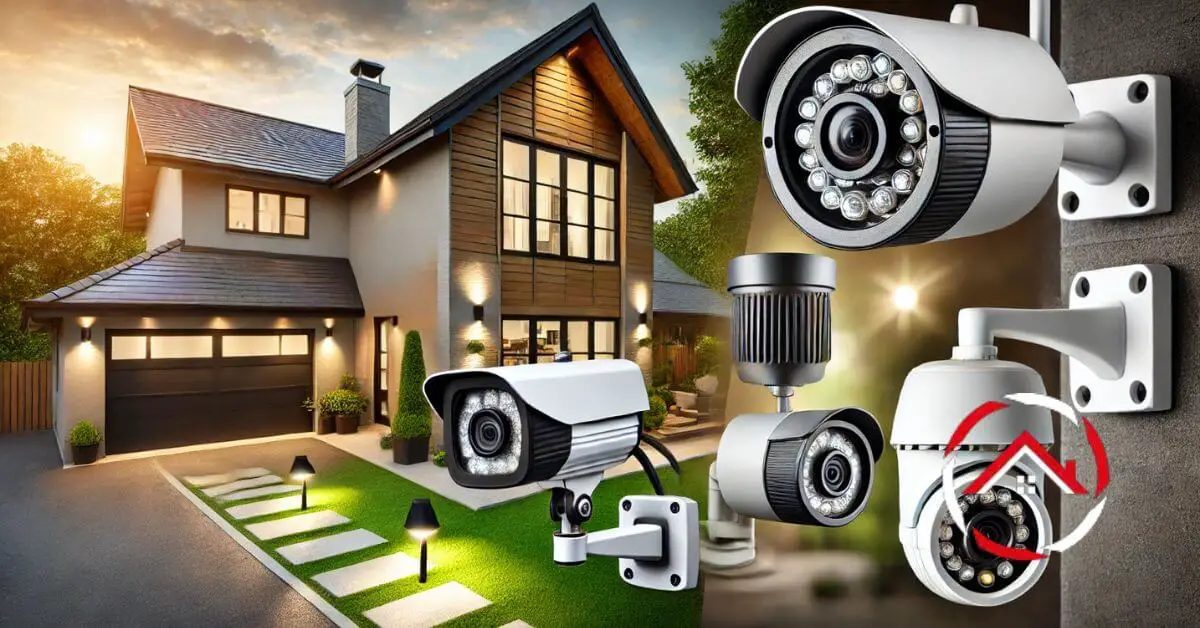Looking to boost your home’s security? Outdoor security cameras are a smart choice. They help you keep an eye on your property, day or night.
With so many options out there, it can be tricky to choose the right one. You want something reliable and easy to use.
Some cameras offer amazing features like night vision, motion detection, and two-way audio. Plus, many can connect to your smartphone.
In this guide, we’ll explore the best outdoor home security cameras. Let’s find the perfect fit for your home and give you peace of mind.
Disclosure: This post contains affiliate links. If you purchase through these links, I may earn a small commission at no extra cost to you.
Read more: Home Security Cameras
Table of Contents
What is the Best Overall Outdoor Camera?
When considering the best overall outdoor camera, the Arlo Pro 5S 2K stands out with its impressive 2K resolution and wide 160° field of view.
The Arlo Go 2 offers flexibility with its cellular connectivity, making it perfect for remote locations.
The Ring Spotlight Cam Plus combines a bright spotlight with 1080p resolution, enhancing visibility at night.
The Blink Outdoor Plus is budget-friendly and features a long battery life, making it a practical choice.
Lastly, the Google Nest Indoor/Outdoor Cam (2nd Gen) provides seamless integration with smart home systems and reliable performance.
Each camera excels in different areas, ensuring there’s a suitable option for everyone.
A Comparison Table of the Best Outdoor Home Security Cameras:
A Comparison Table of the Best Outdoor Home Security Cameras
| Camera Model | Smart Features | Buy |
|---|---|---|
| Arlo Pro 5S 2K | Smart Alerts, 2K Video | 🔴 Buy on Amazon |
| Arlo Go 2 | Mobile connectivity, Smart Alerts | 🔴 Buy on Amazon |
| Ring Spotlight Cam Plus | Motion-activated lights | 🔴 Buy on Amazon |
| Blink Outdoor Plus | Motion detection, customizable settings | 🔴 Buy on Amazon |
| Google Nest Indoor/Outdoor Cam (2nd Gen) | Google Assistant, Smart Alerts | 🔴 Buy on Amazon |
Types of Outdoor Cameras
When it comes to outdoor security cameras, choosing the right type can significantly enhance your home’s safety.
There are various options tailored to different needs and preferences. Understanding these types will help you find the perfect fit for your outdoor surveillance requirements.
1. Wired Outdoor Cameras
- Reliable Power Source: Connected to your home’s electrical system, ensuring continuous power.
- Consistent Video Quality: Offers stable video streaming without interruption.
- Vulnerability to Tampering: Easier for intruders to disable if they can access the wiring.
2. Wireless Outdoor Cameras
- Flexible Placement: Can be installed anywhere within Wi-Fi range, allowing for more versatile positioning.
- Easy Installation: Typically requires less wiring and can often be mounted quickly.
- Signal Interference: May experience connectivity issues due to obstacles or distance from the Wi-Fi router.
3. Battery-Powered Cameras
- Convenience: Can be placed in remote areas without power outlets.
- Rechargeable or Replaceable Batteries: Offers flexibility but requires regular battery checks.
- Limited Features: May lack some advanced functionalities due to power constraints.
4. Solar-Powered Cameras
- Eco-Friendly: Utilizes solar energy, reducing electricity costs and environmental impact.
- Self-Sustaining: Often doesn’t require battery changes, as they recharge from sunlight.
- Dependence on Weather: Performance can vary based on sunlight availability.
5. PTZ (Pan-Tilt-Zoom) Cameras
- Full Coverage: Allows users to remotely control the camera’s movement for a wider view.
- Detail Observation: Can zoom in on specific areas for closer inspection.
- Higher Cost: Generally more expensive than fixed cameras due to added features.
Factors to Consider When Choosing an Outdoor Camera
Choosing the right outdoor camera involves several critical factors that can impact its effectiveness and suitability for your security needs. Here are the key considerations:
1. Resolution
- Clarity: Higher resolution provides clearer images, making it easier to identify faces and details.
- Options: Look for at least 1080p; some cameras offer 2K or 4K for enhanced quality.
2. Field of View
- Coverage Area: A wider field of view means fewer cameras are needed to cover large areas.
- Degrees: Cameras typically range from 90° to 180°; choose based on the area you want to monitor.
3. Night Vision
- Visibility: Ensure the camera has effective night vision capabilities for monitoring in low-light conditions.
- Types: Color night vision provides clearer images at night compared to infrared.
4. Weather Resistance
- Durability: Look for cameras rated for outdoor use, often indicated by an IP (Ingress Protection) rating.
- Materials: Choose cameras made from weather-resistant materials to withstand harsh conditions.
5. Power Source
- Wired vs. Wireless: Determine if you prefer a wired camera (continuous power) or a wireless option (flexibility and ease of installation).
- Battery Life: If choosing battery-operated cameras, consider how often you’ll need to recharge or replace batteries.
6. Storage Options
- Local Storage: Some cameras come with SD card slots for local video storage.
- Cloud Storage: Many offer subscription services for cloud storage; assess costs and storage duration.
7. Smart Features
- Integration: Consider cameras that integrate with smart home systems for added convenience.
- Notifications: Look for features like motion alerts, real-time notifications, and live streaming capabilities.
8. Two-Way Audio
- Communication: Enables interaction with visitors or intruders via built-in speakers and microphones.
- Security Benefits: Can deter potential threats by allowing you to speak directly to someone on your property.
9. Installation
- DIY vs. Professional: Some cameras are easier to install than others; consider your comfort level and the complexity of installation.
- Mounting Options: Ensure the camera comes with necessary mounting hardware or brackets.
10. Cost
- Budget: Determine your budget and explore options within that range.
- Long-Term Investment: Consider the camera’s features and reliability as part of your overall security investment.
By evaluating these factors, you can choose an outdoor camera that best fits your specific security needs and provides peace of mind.
Top Brands and Models of Outdoor Cameras
When selecting an outdoor camera, it’s essential to consider reputable brands and their top models.
Some brands are renowned for their advanced technology, reliability, and user-friendly features.
Below, we’ll explore the top brands and models of outdoor cameras, highlighting their unique features and strengths to help you make the best choice for your security needs.
1. Arlo
- Arlo Pro 5S 2K
- Resolution: 2K video for enhanced clarity.
- Field of View: 160° for wide coverage.
- Night Vision: Color night vision capabilities.
- Two-Way Audio: Yes, allows for communication.
- Smart Features: Advanced AI features for smart alerts.
- Arlo Go 2
- Resolution: 1080p for clear video.
- Field of View: 130° coverage.
- Night Vision: Infrared night vision.
- Power Source: Battery-operated, ideal for remote areas.
- Smart Features: Mobile connectivity for on-the-go monitoring.
| Arlo Pro 5S 2K |
|---|
 |
| Top Features: |
| ✔ 2K HDR Video – Crisp and detailed footage for enhanced security |
| ✔ Color Night Vision – See in full color even in low-light conditions |
| ✔ Dual-Band Wi-Fi – Connect to both 2.4GHz and 5GHz networks for a stronger signal |
| ✔ 160° Field of View – Wide-angle coverage to monitor more space |
| ✔ Smart Motion Detection – AI-powered alerts for people, animals, vehicles, and packages |
| ✔ Two-Way Audio – Talk to visitors in real-time through the built-in microphone and speaker |
| ✔ Integrated Spotlight & Siren – Deter intruders with a powerful siren and motion-activated spotlight |
| ✔ Rechargeable Battery – Long-lasting battery life for extended use |
| ✔ Weather-Resistant – Works in rain, snow, and extreme temperatures |
| Customer Ratings: ★★★★☆ (4.7/5) |
| Buy on Amazon |
2. Ring
- Ring Spotlight Cam Plus
- Resolution: 1080p for reliable video quality.
- Field of View: 140° for ample coverage.
- Night Vision: Color night vision for better visibility.
- Two-Way Audio: Yes, to interact with visitors.
- Smart Features: Integrated spotlight and motion-activated alerts.
| Ring Spotlight Cam Plus |
|---|
 |
| Top Features: |
| ✔ 1080p HD Video – Clear and detailed footage for enhanced security |
| ✔ Color Night Vision – Full-color visibility even in low-light conditions |
| ✔ Motion-Activated LED Spotlights – Two bright LEDs to illuminate and deter intruders |
| ✔ Two-Way Talk – Communicate with visitors in real-time |
| ✔ Built-In Security Siren – Manually activated siren to scare off unwanted guests |
| ✔ Versatile Power Options – Available in Battery, Plug-In, Wired, and Solar versions |
| ✔ Customizable Motion Detection – Set specific motion zones to focus on important areas |
| ✔ Works with Alexa – Integrates seamlessly with Amazon Alexa for voice control |
| Customer Ratings: ★★★★☆ (4.5/5) |
| Buy on Amazon |
3. Blink
- Blink Outdoor Plus
- Resolution: 1080p for decent image quality.
- Field of View: 110° for suitable coverage.
- Night Vision: Infrared night vision for low-light conditions.
- Power Source: Battery-operated with a long lifespan.
- Smart Features: Customizable motion detection settings.
| Blink Outdoor 4 |
|---|
 |
| Top Features: |
| ✔ 1080p HD Video – Clear and detailed footage for enhanced security |
| ✔ 143° Field of View – Wide-angle coverage to monitor more space |
| ✔ Infrared Night Vision – Clear video recording even in low-light conditions |
| ✔ Two-Way Audio – Communicate with visitors in real-time |
| ✔ Motion Detection – Receive alerts when movement is detected |
| ✔ Weather-Resistant – Designed to withstand various weather conditions |
| ✔ Extended Battery Life – Operates up to two years on two AA lithium batteries |
| ✔ Easy Installation – Wire-free setup for convenience |
| ✔ Works with Alexa – Integrates seamlessly with Amazon Alexa for voice control |
| Customer Ratings: ★★★★☆ (4.5/5) |
| Buy on Amazon |
4. Google Nest
- Google Nest Indoor/Outdoor Cam (2nd Gen)
- Resolution: 1080p for clear visuals.
- Field of View: 130° for sufficient coverage.
- Night Vision: Infrared night vision capabilities.
- Two-Way Audio: Yes, for direct communication.
- Smart Features: Seamless integration with Google Assistant.
| Google Nest Cam Indoor/Outdoor (2nd Gen) |
|---|
 |
| Top Features: |
| ✔ 1080p HD Video with HDR – Clear and detailed footage in various lighting conditions |
| ✔ Battery-Powered – Flexible installation without the need for wiring |
| ✔ Weather-Resistant – Designed to withstand outdoor elements |
| ✔ Intelligent Alerts – Differentiates between people, animals, and vehicles |
| ✔ Two-Way Audio – Communicate with visitors in real-time |
| ✔ Night Vision – Clear visibility in low-light conditions |
| ✔ Easy Installation – Wire-free setup for convenience |
| ✔ Works with Google Assistant – Seamless integration with Google Home ecosystem |
| Customer Ratings: ★★★★☆ (4.6/5) |
| Buy on Amazon |
5. Reolink
- Reolink Argus 3 Pro
- Resolution: 2K video quality.
- Field of View: 122° for adequate coverage.
- Night Vision: Color night vision available.
- Power Source: Rechargeable battery or solar panel option.
- Smart Features: Motion detection alerts and two-way audio.
| Reolink Security Cameras |
|---|
 |
| Top Features: |
| ✔ High-Resolution Video – Up to 12MP Ultra HD |
| ✔ Dual-Band Wi-Fi – Supports 2.4 GHz & 5 GHz |
| ✔ Smart Detection – Identifies people and vehicles |
| ✔ Two-Way Audio – Real-time communication |
| ✔ Weatherproof Design – Suitable for all conditions |
| Customer Ratings: ★★★★☆ (4.6/5) |
| Buy on Amazon |
These top brands and models provide a variety of features and capabilities, ensuring you find the perfect outdoor camera to meet your security needs.
How Do you Place and Install an Outdoor Camera?
Installing an outdoor camera is a straightforward process, but it requires careful planning to ensure optimal placement and functionality.
Here’s a step-by-step guide on how to place and install an outdoor camera effectively:
Step 1: Determine Placement
- Identify Coverage Areas: Choose strategic locations to monitor vulnerable areas, such as entrances, driveways, and backyards.
- Height Consideration: Mount the camera at a height of 8 to 10 feet to avoid tampering while ensuring a clear view.
- Avoid Obstructions: Ensure that trees, bushes, or walls do not obstruct the camera’s field of view.
Step 2: Check Connectivity
- Wi-Fi Signal: If using a wireless camera, check the Wi-Fi signal strength at the chosen location. You may need a Wi-Fi extender if the signal is weak.
- Power Source: Ensure there is a power outlet nearby if the camera requires a wired connection or additional power.
Step 3: Gather Tools and Materials
- Required Tools: Prepare a drill, screwdriver, ladder (if needed), and level.
- Installation Kit: Most outdoor cameras come with a mounting bracket, screws, and anchors. Ensure you have everything you need before starting.
Step 4: Install the Mounting Bracket
- Mark the Drill Points: Hold the mounting bracket against the wall at the desired location. Use a pencil to mark where to drill.
- Drill Holes: Drill holes into the marked spots. If using anchors, insert them into the wall before proceeding.
- Attach the Bracket: Secure the mounting bracket using screws provided in the installation kit. Use a level to ensure it is straight.
Step 5: Attach the Camera
- Mount the Camera: Attach the camera to the mounting bracket as per the manufacturer’s instructions. Ensure it is securely fastened.
- Adjust the Angle: Position the camera to capture the desired area. Make sure to account for the camera’s field of view.
Step 6: Connect to Power and Wi-Fi
- Plug In: If using a wired camera, connect it to the power outlet. For battery-powered models, insert the batteries and ensure they are charged.
- Connect to Wi-Fi: Follow the camera’s app or user manual to connect it to your home Wi-Fi network.
Step 7: Configure Settings
- Download the App: If applicable, download the camera’s app on your smartphone for remote access.
- Adjust Settings: Configure motion detection, alerts, and recording settings according to your preferences.
Step 8: Test the Camera
- Check Live Feed: Open the app to view the live feed and ensure the camera covers the intended area effectively.
- Test Features: Test night vision and two-way audio (if available) to confirm all features are working correctly.
Step 9: Final Adjustments
- Fine-Tune the Angle: Make any necessary adjustments to the camera angle for optimal coverage.
- Secure Cables: If applicable, secure any visible cables with cable clips for a tidy appearance and added protection.
By following these steps, you can successfully place and install an outdoor camera that enhances your home security and provides peace of mind.
Final Word
Choosing the best outdoor camera for your home is essential for safety. With various options available, it’s easy to find one that fits your needs.
Consider features like resolution, night vision, and smart technology. Brands like Arlo, Ring, and Google Nest offer reliable choices.
Remember, a good camera not only captures clear footage but also keeps you connected.
Whether you want to monitor your property or keep an eye on loved ones, the right outdoor camera makes all the difference.
Invest in your peace of mind today, and enjoy the security that comes with a well-placed outdoor camera!
Frequently Asked Questions
What features should I look for in outdoor security cameras?
When choosing outdoor security cameras, consider features like high resolution (1080p or higher), night vision, weatherproof design, and smart home compatibility. Motion detection, two-way audio, and cloud or local storage options are also important for effective monitoring and communication.
Are battery-powered outdoor cameras effective?
Yes, battery-powered outdoor cameras are effective, especially for areas without electrical outlets. They offer flexibility in placement and ease of installation. However, consider models with long battery life and low power consumption to minimize maintenance.
How do outdoor security cameras handle different weather conditions?
Most outdoor security cameras are designed to withstand various weather conditions. Look for models with an IP66 rating or higher, indicating resistance to dust and heavy rain. This ensures reliable performance in rain, snow, or extreme temperatures.
Can I access my outdoor security cameras remotely?
Yes, many outdoor security cameras offer remote access via mobile apps. This allows you to view live feeds, receive alerts, and manage settings from anywhere with an internet connection. Ensure the camera you choose supports this feature for optimal convenience.


